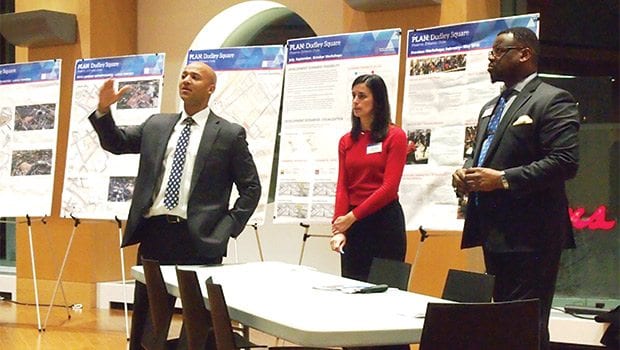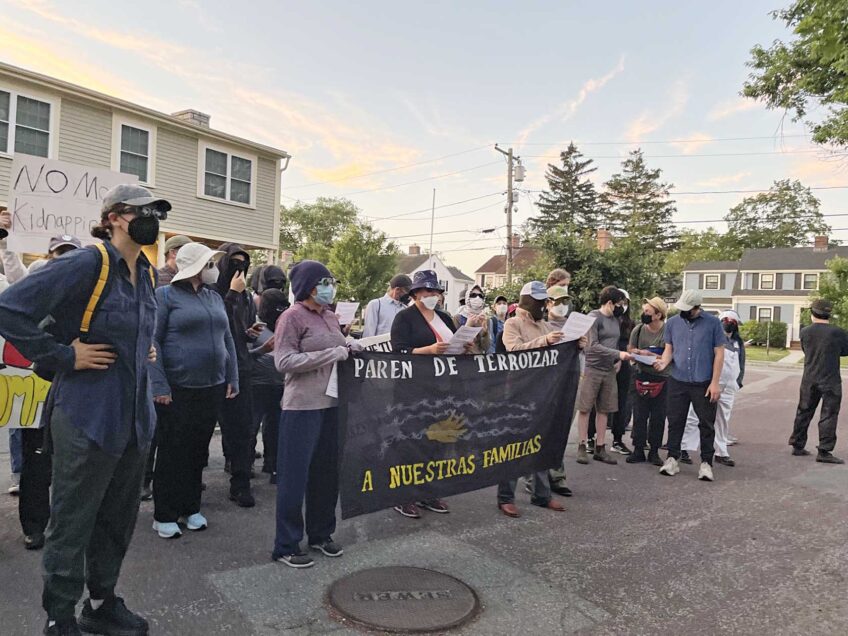
For much of 2016, the Boston Planning and Development Agency’s Plan Dudley process has been low-key. During the year, a small collection of community residents, developers, community development corporation staff and city officials have attended nine planning events in and around Dudley Square.

City Councilor Tito Jackson makes a point during the BPDA’s Plan Dudley meeting.
Yet simmering tensions between community residents and city officials boiled to the surface last week when BPDA officials presented design principles aimed at guiding area development. Community residents pushed back, questioning whether the agency’s efforts will displace current Roxbury residents amidst a building boom.
BPDA officials began the planning process in January, concentrating on six vacant publicly-owned parcels of land between Dudley Square and Roxbury Crossing. They solicited community views and concerns regarding land use, transportation, economic development and other issues.
Beyond the vacant parcels are several large construction projects in the immediate area with 4.9 million square feet that either are approved for construction or currently under construction. This development is expected to yield 2,118 residential units and 1,091,065 square feet of retail and office space.
Among the major projects in various stages of review are:
- Tremont Crossing at Whittier and Tremont Streets, where developers are planning 694 residential units in addition to retail and office space and parking;
- Bartlett Place with 33 residential units and 54,000 square feet of commercial space;
- the Whittier Choice plan, which calls for the redevelopment of the 200 units of affordable housing currently in the Whittier Street public housing development with an additional 272 units of market rate housing developed on the site; and
- Melnea Hotel and Residences, with 52 units of housing and a 150-room hotel.
Affordability concerns
Attendees at Monday’s meeting, held just before Thanksgiving, questioned whether the BPDA’s requirement that 13 percent of new construction be affordable would be sufficient, given that most people in Roxbury earn less than half the area median income in the Greater Boston area.
“We live in a community where the median income is $33,000 a year,” said former City Councilor Chuck Turner. “You’re talking about half the people in our community not being able to live here.”
Turner pointed out that many of the units deemed affordable under BRA guidelines are affordable to people earning as much as $68,000, which is 100 percent of the area median income.
“Your use of the term ‘affordable’ is very confusing,” he said. “It doesn’t tell us how much the people renting are going to have to pay. That ‘affordable’ term is a blanket word that covers the reality.”
Boston’s Chief of Economic Development John Barros cautioned that it was too early to argue about affordability, given that the BPDA yet to release requests for proposals for the six vacant parcels where planning currently is underway. The RFPs will be released early next year and will be subject to review by the Roxbury Strategic Master Plan Oversight Committee.
“When we come back, you’ll be able to look at the RFP,” he said. “It’s in the oversight committee’s purview to say ‘We’ve heard from the community. Here’s what we’re looking for.’ There are many steps in the process for the community to say ‘yes’ or ‘no.’”
City Councilor Tito Jackson, who initiated a Roxbury-wide planning process called Reclaim Roxbury in 2015, suggested neighborhood residents would rather draft the RFPs for the vacant parcels themselves.
“There is no more vacant land downtown and two-thirds of all the vacant land in Boston is in Roxbury,” he said. “The [BPDA] wants to determine what gets built here. That’s unacceptable. All I’m hearing is RFP, RFP. We’re not going for it. We are not planning to displace ourselves.”
“People here are talking about community development,” said Roxbury resident Floyd Hardwick. “The language you’re using here is real estate development. We’re not even understanding each other.”
Planning challenges
The meeting was heated at times, mirroring the conflicts that roiled the Plan JP/Rox process, where a group of affordable housing activists protested against what they said was a lack of affordability in new construction along the Washington Street corridor in the area between Jackson Square, Egleston Square and Forest Hills, where the BPDA is seeking to guide redevelopment efforts. In that area, BPDA officials pointed out that most of the land is privately owned, curtailing the agency’s leverage to demand more than the 13 percent affordability called for by the guidelines in the city’s inclusionary development policy.
In the Dudley planning area, the process revolves around publicly-owned parcels of land, many of which were taken during urban renewal and the aborted Interstate 95 expansion plan. Jackson suggested that Barros, a former executive director at the Dudley Street Neighborhood Initiative, look into the same land trust schemes that organization used to preserve housing affordability in its catchment area.
“You’re an expert in that area,” he said.
Barros said the planning process has not produced a consensus on affordability for the planning area, noting the conflicting calls for deeper subsidies and more market-rate housing.
“Some people are talking about 1/3 [affordable], 1/3 [moderately affordable], 1/3 [market rate],” he said. “What does that look like in Roxbury?”
Turner said more work must happen before it will make sense for the BPDA to present final Plan Dudley recommendations.
“The next step is for you not to develop RFPs, but to develop different strategies around housing,” Turner said. “If you’re trying to create housing through RFPs, it’s a real estate project, not a community development project.”







